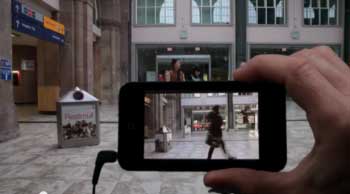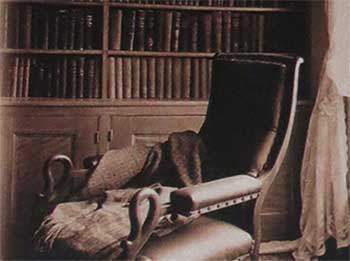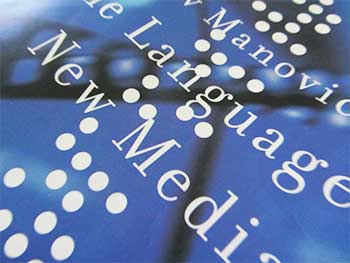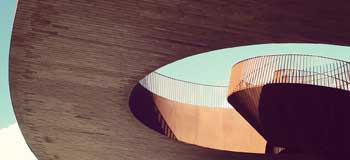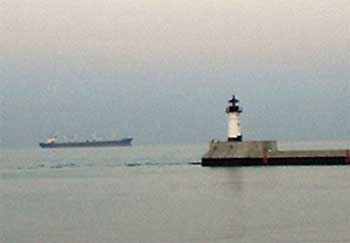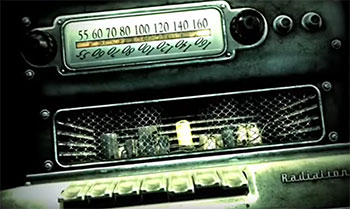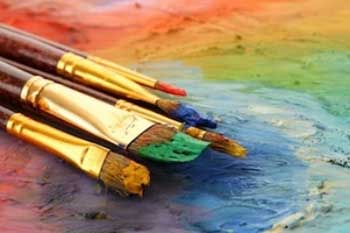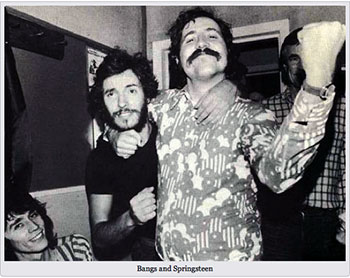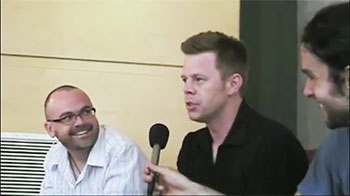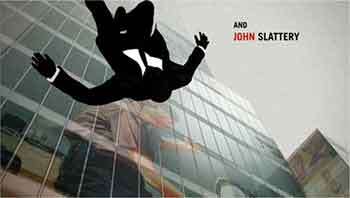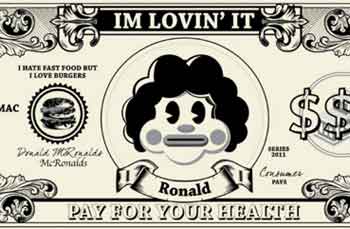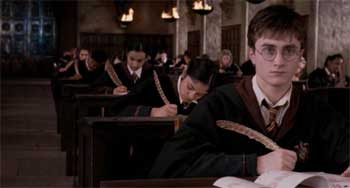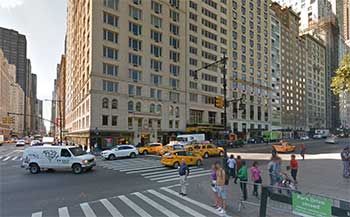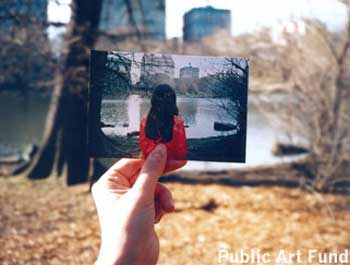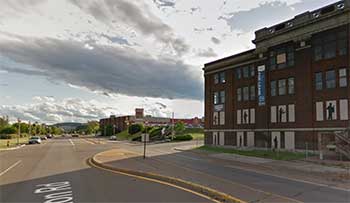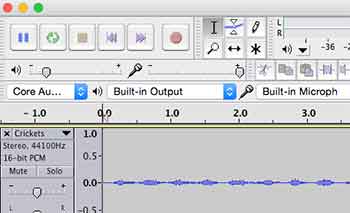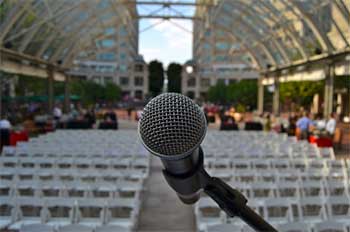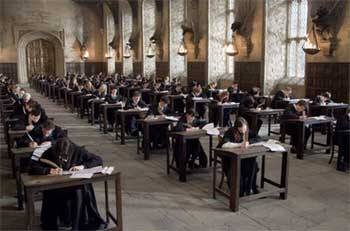WEEK 1 |
Day 1: New Media/Writing
Roll and IntroductionsAssignment for Next TimeSee the assignment below, left column New Media / WritingNot a discipline, but a war First ProjectSee the assignment for the Social Creativity Project Resources
|
|
| WEEK 2 M 1/16 |
MLK Holiday: No Class Meeting |
|
| W 1/18 | Homework: BirkertsReadingsPrintout, read, mark, and bring in Sven Birkerts'
from his book The Gutenberg Elegies, both available as PDFs via the course Moodle site. Follow the "Moodle" link in the menu above, and then open the PDF files under the section heading "Readings"). Practice Active ReadingAs you read these assignments, try practicing the techniques of Active Reading as you look for responses to the following questions. Be sure to mark your printouts to show where and how Birkerts speaks to these issues: Thought Questions1. In what particular ways does Birkerts define writing and reading? 2. How do these styles of writing and reading represent not just literary practices but social, personal, and political values and ways of living? 3. How does "New Media" or networked life threaten these ways of writing, reading, and living? What values, experiences, or abilities does New Media make obsolete? 4. In what ways is Birkerts' writing an example of the kind of writing (and set of values) that he is defining and describing? Do not come to class without these printouts! You can printout a PDF with two pages per sheet if you wish. AdviceNote that the first paragraph of Chapter 1 is something of a false start: dense and vague. Start with the second paragraph. Come back and read the first paragraph after you've finished the chapter. Photocopy One Page to Turn InAfter you have read and marked the two chapters, choose one page to photocopy or scan/print and bring to class to turn in to show an example of your reading actively. Be sure to write your name in the upper right corner of the page. SyllabusRead over the syllabus carefully and come in with any questions.
|
Day 2: Birkerts' Reading and Writing
|
| WEEK 3 M 1/23 |
HomeworkLog Your Classroom ContributionsIn replies to the the Moodle forum "Classroom Contributions," please make note of any quotations from the readings which you orally raised and commented on in class last time. See the full directions on the syllabus. ReadPrintout, read, mark, and bring in Lev Manovich's "What is New Media?" (Chapter One from this book The Language of New Media). This chapter is available as PDFs via the course Moodle site. Follow the "Moodle" link in the menu above, and then open the PDF file under the section heading "Readings To Print"). Practice Active ReadingAs you read, try practicing the techniques of Active Reading as you look for passages and statememts relevant to the following questions.
Come in ReadyCome in ready to offer and discuss what you marked, experienced, and thought about while reading this chapter. |
Day 3: Manovich: What is New Media? |
| W 1/25 | HomeworkA Close Reading of Social Creativity (Moodle Post)The Set UpIn class, we spent some time doing a close reading of this instance from the "Sad Chair" project. (Visit this page for much more on close reading.) A close reading like this helps us to understand how a creative vision can be defined in a set of Steps, Rules, and Guidelines like those on the handout you received last time. The TaskFrom one of the sample social-creativity projects on the assignment page (or a another example that you've found on the web), choose one example (that is, one "instance") to do a close reading of. For example, if you chose the "Make Your Franklin" project, you could do a close reading of the McDonald's-themed "I'm Loving It!" instance. Post to MoodleBy Wednesday at noon, post a reply to the Moodle Forum "A Close Reading of a Social Creativity Instance." In this reply, include a link to the instance of social creativity that you've chosen to talk about, and write a paragraph analyzing this example of the project. This analysis should explain how the various creative choices made in the composition function together to produce a particular effect and meaning. Your paragraph should also evaluate the creative potential of the project's format, and the extent to which the particular instance realizes that potential (or not). |
Day 4: Dreamweaver Prototype
Review Manovich's 5 CharacteristicsCreate on your USB DriveOn your USB drive, create the following set of nested folders: new media writing www 4250 exercises social was assets If you don't have a USB drive available today in class, log into the lab's "My Files" space in your lab computer and save all of the above there. ("My Files" is a storage space on the network where you can store files and access them from any lab.) When you have your USB with you, you will be able to copy all of the folders and files you've created for this class in "My Files" and paste them into your USB drive. Exercise: Page from Prototype (Your Social Creativity Page)Today we will work on the exercise "Web Page From Prototype." I will give you a copy of the handout.
Using the "Page from Prototype" for Your ProjectYou will use this exercise page as the platform for presenting all the elements of the Social Creativity Project (except for the Commentary, which you will turn at the beginning of the class meeting after the project is due
|
| WEEK 4 M 1/30 |
HomeworkWrite, Revise, and BringOn your USB drive, write, revise, and bring in drafts of these three elements of your Social Creativity Project:
|
Day 5: Dreamweaver Sites and Photoshop
To Get Ready for Class Today
Exercise: Setting Up a "www" Site in DreamweaverI will give you a copy of the handout "Setting Up a "www" Site in Dreamweaver and Using It to Upload Files and Folders." Turning in Page to Prototype
Exercise: BannersWe will do together in class the exercises Beginning and Intermediate Banner Techniques (Photoshop).
|
February
|
||
| W 2/1 | HomeworkSend Me a Prospectus for your Social Creativity Project (by Tuesday at 11 p.m.)By Tuesday night, complete the form "Prospectus: Social Creativity Project" Studio Day: Bring What You Need to WorkBring in all materials necessary to work on your Social Creativity Project in class. Though you will be working individually on this Studio Day, this is still a class meeting, and you will be expected to be on time and to stay till the end working productively and helping others.
|
Day 6: Studio Session: Social Creativity
|
| F 2/3 | Social Creativity Project Due by 4:00Online Aspects Due by NoonThe online aspects of the project are due by 4:00 today. To turn in the project:
|
Friday: No Class Meeting |
| WEEK 5 M 2/6 |
HomeworkPrinted Commentary on the Social Creativity ProjectI will pick up the printed copy of your commentary at the beginning of class. See the commentary requirements on the assignment page (8-12 under "Criteria") ReadRead the following from Tom Bissell's Extra Lives using the techniques of Active Reading:
Three Quotations: TensionsBissell is, by profession, a fiction writer and critic--though a writer/critic who also loves video games. In essence, Bissell is half Birkerts, half Manovich.
Come in with three quotations identified--with page numbers--that provide clues that might help answer the questions above. Be prepared to discuss your choices and explain their implications. ResourceA Play-Through of Fallout 3, Part 1 from YouTube |
Day 7: Bissell's Extra Lives: Tensions and Contradictions[ Meet in ENGR 177]
Resources:
|
| W 2/8 | HomeworkRead BissellRead Tom Bissell's Extra Lives, pages 17-65 (Chapters 2-4) using the techniques of Active Reading. Five Transformative Terms, Phrases, or ExamplesIn addition to the ideas presented, the value of a book like Bissell's comes from the
that author provides us, which we can use as critical tools for thinking not only about video games, but about lots of other issues of media and culture. Bring to Class on PaperFrom the chapters read for today, write down five such terms, phrases, or examples that seem potentially useful as critical terms we could borrow for our own thinking and writing. Beside each, make a sentence or two of notes about how Bissell is using that term, phrase, or example to understand and say something in Chapters 2-4. Be ready to discuss how and why you see each of these terms/phrases/examples as offering a useful or powerful critical tool for your own writing (whether about video games or about some topic in media, culture, or writing). Log Your Classroom ContributionsIn replies to the the Moodle forum "Classroom Contributions," please make note of any quotations from the readings which you orally raised and commented on in class last time. See the full directions on the syllabus.
|
Day 8: Bissell's Extra Lives 2[ Meet in ENGR 177]
Narrative, Intelligence, ArtResources
|
| WEEK 6 M 2/13 |
HomeworkLog Your Classroom ContributionsIn replies to the the Moodle forum "Classroom Contributions," please make note of any quotations from the readings which you orally raised and commented on in class last time. See the full directions on the syllabus. Read BissellExtra Lives, page 66-183 (the end) using the techniques of Active Reading. Two Threads in Eight PassagesBelow are some of the terms and phrases you identified as transformative or revealing from the opening chapters of Extra Lives. Ideally, these topics represent not just isolated, incidental notions, but the beginnings of threads that Bissell will continue to develop through the rest of the book. Choose Two Threads to FollowChoose two of the ideas below (under "Possible Threads") to track as you read the remainder of Extra Lives. (If you feel irresistibly compelled, you may choose one thread of your own that does not appear below.) What to Write Down for ClassCome to class with eight passages identified on paper with page numbers from today's assigned reading. These eight passages should point to particular instances where you see Bissell addressing and further developing one of the two threads you've chosen to follow. You don't need to write down the entire quotation, just a "word tag" (that is a few key words) and the page number with tenths (".3" for example) to indicate how far down the page the passage appears. For each word tag, make some notes on how that passage adds to Bissell's development of that idea. Some questions you might consider: -- Does Bissell solve any of the problems he identifies in opening chapters? -- Does he further problematize, contextualize, or deepen a question or dilemma that he's raised without resolving it? Possible Threads (Passages from Your "Five Transformative Terms" Homework):
|
Day 9: Bissell: Criticism[ Meet in ENGR 177]QuestionHow does that theme exemplify and contribute to Bissell's critical vision of video games as an art form? Resources
|
| W 2/15 | HomeworkLog Your Classroom ContributionsIn replies to the the Moodle forum "Classroom Contributions," please make note of any quotations from the readings which you orally raised and commented on in class last time. See the full directions on the syllabus. Write, Print, and Bring InA. Choose a passage from today's reading in Bissell which sums up a critical idea that could be used in an analysis of a piece of New Media or a video game. B. Find two other quotations that connect and add to that essential idea in the first quotation:
C. Print the document and bring to class.
|
Day 10: Bissell: Narrative and Database
Exams HandoutI will give you a copy of the handout "What to Remember, Understand, and Be Able to Discuss for the Exams." Please change the page number in the upper right from 5 to 21 Narrative and Database HandoutI will give you a copy of the handout "Narrative and Database" (from Lev Manovich's The Language of New Media). This is page 22 in our sequential list of semester handouts. Resources
|
| WEEK 7 M 2/20 |
HomeworkLog Your Classroom ContributionsIn replies to the the Moodle forum "Classroom Contributions," please make note of any quotations from the readings which you orally raised and commented on in class last time. See the full directions on the syllabus. Read
15 Quotations to Answer 5 QuestionsAs you read, note down the page numbers (including tenths) of passages that help to answer the questions below. On average your will need three quotations per question to get 15. In addition to the page number, also write down 1-5 key words from eacg quotation to serve as a "tag" to help you recall what that quotation said. On paper, bring your list of quotation tags and page numbers. The Questions1. Software 2. Software Studies 3. History, the Present, the Future 4. Alan Kay 5. Extendibility Make a ClusterOn another sheet of paper, make a cluster of words and ideas from the 15 quotations to attempt to map relationships among them. As an example of clustering, remember the exercise we did on the board last class meeting. Also see my web page on clustering for details of this brainstorming technique). Indicate relationships, patterns, sequences, and oppositions that you see among the nodes with lines and various arrows, and notes of your own in squares (to contrast with the circled items from the reading). Keep clustering and drawing lines until you have at least twelve nodes in your cluster (try for more if you can). Write a Summing-Up SentenceImmediately when you're done clustering, write down at the bottom, or the back, a sentence summing up something you see in the relationships of two or more items on the cluster. Try to write something that you hadn't thought of before making the cluster. This statement might be about a very specific thought or a broad idea, but it should relate to a topic or example raised explicitly by Manovich. |
Day 11: Manovich, Software 1[ Meet in ENGR 177]
Resources |
| W 2/22 | HomeworkLog Your Classroom ContributionsIn replies to the the Moodle forum "Classroom Contributions," please make note of any quotations from the readings which you orally raised and commented on in class last time. See the full directions on the syllabus. ReadRead Chapter 2 of Lev Manovich's Software Takes Command, pages 107-157 Annotate the "Metamedium" DiagrapmIn class, I gave you a copy of the handout, "Lev Manovich's 'Metamedium.'" What This IsThis handout gives you a "semiotic square" composed of two opposing terms (dichotomies, binaries) that are at the core of Manovich's Chapter Two:
A semiotic square is a format that enables you to take two sets of opposing terms like these and lay them across one another, creating a two-dimensional field of possibilities for analysis. What To DoAs you read Chapter 2, note down page numbers (with tenths) and key words that help you understand each of the four terms around the outside (in black: New Properties, etc) and the oppositions among them. Also note down pages number and key words for the hybrid terms inside the lines (in gray: for example "New Media Specific") What You're Reading ForManovich argues that software is a "metamedium" composed of these four characteristics (that is, these two pairs of opposing terms). These sets of distinctions on this chart are the beginning of his thinking, rather than his end or conclusion. He spends the chapter stress-testing, questioning, and problematizing the truth and usefulness of these oppositions and the meaning of their relationships: Is there a problem, for instance, in distinguging just what is "old" and "new"? Does what is new come from the old? Does old become new through some kind of process? Or does the new come from new conditions that make the old obsolete?
Write a PragraphOn another sheet of paper, write a substantive paragraph about some issue or question Manovich raises, or some example that he uses to understand what a "metamedium" is.
|
Day 12: Manovich, Software C2[ Meet in ENGR 177]
Consider an Optional RevisionConsider an option revision of your Social-Creativity Project for a new grade on the project (based on figuring 1/3 of the original grade and 2/3 of a new grade). This revision would not be a simple fixing up of the project, but a substantial revision that we would work on collaboratively. The revision option is open only to those whose project was submitted on time and complete by the original deadline. See the page "Collaborative Revision Process," for more details, and the Revision Contract that governs the process. Deadline for meeting with me about a revision of the Social Creativity Project is Wednesday, March 8. The final revision itself would be due several weeks after our first meeting about it, on a date we would agree to. Resources
|
| WEEK 8 M 2/27 |
HomeworkLog Your Classroom ContributionsIn replies to the the Moodle forum "Classroom Contributions," please make note of any quotations from the readings which you orally raised and commented on in class last time. See the full directions on the syllabus. ReadRead the Chapter 3 of Lev Manovich's Software Takes Command, pages 161-198 Cluster of 12 Quotation Tags1. Before you start reading, get a blank sheet of paper to make a cluster out of 12 "quotation tags" that you will choose from the chapter. Remember a quotation tag is a page number (with tenths) and 1-5 key words from the quotation which help you remember it. 2. Open and read through again this page of steps for productive clustering techniques. 3. At the center of the page, write "Hybrid Media is Not Multimedia" 4. With your choice of tags, try to show why Manovich believes the statement is true. You might also explore:
5. When you finish, remember to write at the bottom or on the back of the page a phrase or sentence that captures some idea in your head about what you've been clustering on. Consider an Optional RevisionConsider an option revision of your Social-Creativity Project for a new grade on the project (based on figuring 1/3 of the original grade and 2/3 of a new grade). This revision would not be a simple fixing up of the project, but a substantial revision that we would work on collaboratively. The revision option is open only to those whose project was submitted on time and complete by the original deadline. See the page "Collaborative Revision Process," for more details, and the Revision Contract that governs the process. Deadline for meeting with me about a revision of the Social Creativity Project is Wednesday, March 8. The final revision itself would be due several weeks after our first meeting about it, on a date we would agree to.
|
Day 13: Manovich, Software C3[ Meet in ENGR 177]
Resources |
March
| W 3/1 | HomeworkLog Your Classroom ContributionsIn replies to the the Moodle forum "Classroom Contributions," please make note of any quotations from the readings which you orally raised and commented on in class last time. See the full directions on the syllabus. ReadRead the Chapter 4 of Lev Manovich's Software Takes Command: "Soft Evolution," pages 199-239, using the techniques of Active Reading. Write a Summary of the Chapter's Analytical PlotWhat to WriteWrite up to a page (2 or 3 substantial paragraphs) that summarizes the "analytical plot" of Chapter 4. Talk about the chapter's sections as chapters or episodes in that plot. What is an Analytical Plot?In your sentences, make Manovich the subject. Your verbs should characterize what he's doing, step by step, through the chapter. Sharper, more descriptive verbs like "distinguishes," or "questions," or "argues against," are better than generic ones like "says," or "gives." Try to show in your sentences what Manovich does in each section, and how he makes one section lead to the next. See the SampleSee this sample of a plot summary of Chapter Five from Manovich's The Language of New Media. QuotationsBe sure to quote key words and phrases (including page numbers cited parenthetically) to make it possible for you to find what you think are significant or memorable quotaitons from the sections. DocumentationDocument the Manovich book in a "Work Cited" entry at the bottom in MLA citation and documentation format. Print and bring your paragraph(s). Suggestion: Try a Cluster FirstTo help you get a handle of content and flow of chapter, try taking 10 minutes after you read the chapter to make a "chain cluster" on the section titles. Rather than starting a cluster with a single word or phrase at the center (as we've done before), start with a chain of items from left to right that represent the sections. For instance, here are abbreviated versios of the section headings:
Then scan through the chapter, looking for what you marked and noted, fleshing out the cluster with phrases and passages from the reading that suggest the flow and development of Manovich's chapter. |
Day 15: Manovich C4[ Meet in ENGR 177]Resources
|
| M 3/6 | SPRING BREAK |
|
| W 3/8 | SPRING BREAK |
|
| WEEK 9 M 3/13 |
HomeworkLog Your Classroom ContributionsIn replies to the the Moodle forum "Classroom Contributions," please make note of any quotations from the readings which you orally raised and commented on in class last time. See the full directions on the syllabus. Before You Read ManovichIn Chapter 5, Manovich briefly considers the title sequence from the AMC series Mad Men as an example of "motion graphics," the subject of this chapter. Watch this video before you read. Imagine that you are going to write a 20-page essay analyzing this title sequence as an example of what Manovich calls a "new hybrid visual aesthetics" (244) which is characteristic of "'media' after software" (Manovich 4). ReadActively read the Chapter 5 of Lev Manovich's Software Takes Command, pages 243-296, 307-327. Read both for
Watch the Title Sequence AgainAfter you have read and taken notes on the chapter, watch the Mad Men title sequence again. Five Revealing Quotations and Second MarksOn paper, copy over at least five quotations from Chapter 5 in their entirety (with page and tenths numbers) that describe and illuminate details of the title sequence. For each quotation, note down the minute and second mark of shots in the video where you would be able to show us the details that illustrate Manovich's point in the quotation. Try to make your quotation/shot pairings as revealing and "transformative" as possible
|
Day 16: Manovich C5
Resources
|
| W 3/15 | HomeworkLog Your Classroom ContributionsIn replies to the the Moodle forum "Classroom Contributions," please make note of any quotations from the readings which you orally raised and commented on in class last time. See the full directions on the syllabus. Write 5 Questions for the ExamWrite an exam question for each of the five types of content covered on the exam. You can use any of the three question formats for any of the types. See the handouts By noon today, post your questions to the appropriate forums in Moodle in the section "Midterm Exam" Bring to ClassBring to class all books, handouts, and notes from the first half of the course. |
Day 17: Study Session[ Meet in MonH 209 for Today Only ]
Resources
|
| R 3/16 - F 3/17 | Homework: Take-Home Portion of the MidtermTake-Home Portion of the Midterm
|
|
| WEEK 10 M 3/20 |
HomeworkCome PreparedCome to class prepared to take the In-Class Portion of the Exam (composed of the Matching and Fill-in-the-Blank formats). Bring two pens that you trust. There is no need to bring books or notes. |
Day 18: Midterm Exam, In-Class Portion[ Meet in ENGR 177 ]
|
| W 3/22 | HomeworkDownload, Print, and Read"The Poetics of Augmented Space" (Manovich). Pages 1-15. The PDF is available from the course Moodle site under "Readings." Watch, Write, Post to Moodle
|
Day 19: Writing In Augmented Space 1[ Meet in MonH 209]Augmented Space Resources
|
WEEK 11 |
HomeworkThe Myth of OrpheusA key to Cardiff's and Miller's audio walk "Her Long Black Hair" is the myth of Orpheus. We might say that the Orpheus myth provides the skeleton of the walk, and Cardiff and Miller flesh that structure out with themes and details of their own. Before you virtually take the walk (below), read Edith Hamilton's classic retelling of the Orpheus myth. As you take the walk, be on the lookout not only for references to Orpheus or music, but for verbal, visual, or spatial dichotomies of up/down, above/below, forward/backward, looking/not looking, recovery/loss, etc. Make a list of possible references. For each, note Track number and, if possible, minute/second mark. Remember the Big QuestionDuring the walk, also be thinking about the Big Question we asked last time in class: How do we make a place speak of the ideas and feelings we hope to evoke in an audience? Take the WalkVisit the archive web page for Cardiff's and Miller's Her Long Black Hair. There you will find links to all files needed for the walk. (Note that this page is similar to the web page I will ask you to create for your own project.) Open
Open these in multiple tabs in your browser so you are able to simultaneously listen to the audio track as you look at the map or photograph (when directed). In another tab or window, try to follow the route visually using the following Google Street Views of the walkways in Central Park: Google Street Views for Walk
Make a Cluster1. Make a cluster of the possible references to Orpheus or Orpheus-related dichotomies (above/below, etc.) 2. Add to your cluster themes or details that you notice from Cardiff's and Miller's non-Orpheus materials. How does the Orpheus material unify and give shape to those themes and details? Do those themes and details add up to any broader meanings or effects worth mentioning? 3. Finally, add special notations--perhaps with squares rather than circles around the items, or marked in some other distinct way--instances of techniques we might learn from to make a place speak as a medium of writing. |
Day 20: Writing In Augmented Space 2[ Meet in MonH 209]
|
| W 3/29 | HomeworkWrite a ParagraphWrite an Exploratory/Focusing Paragraph to invent a possible topic for the WAS assignment. Bring the paragraph to class in two forms:
Read "Juggling"Read the handout "Juggling" and think about opportunities in your imagined WAS project (above) where you might be able to practice this technique. Juggling gives us a verbal means of moving a reader from the here-and-now to something else (the past, the future, an idea, a line of thought.etc.)
|
Day 21: Writing in Augmented Space 3:
|
April
| WEEK 12 M 4/3 or W 4/5 |
HomeworkPreparing for Required ConferencePrepare for your conference either today (Monday), or Wednesday See the Moodle Wiki for one of these days to sign up. Bring to your conference:
For an example of what you should prepare and bring to the conference, see the sample project description "Borne Ceaselessly" |
Day 22 and 23: Individual Conferences: No Class Meeting (WAS 4&5)[Conferences in 437 Humanities, which is inside the 420 Humanitites Suite] |
| WEEK 13 M 4/10 |
HomeworkSeek InspirationBefore attempting to write your the portion of draft script (see below), seek inspiration by 1. Reading about your place, its history, or topics that you are planning to use to augmented your place. 2. Reading, listening to, or watching models of the genre of writing you are translating to augmented space (for example, a model poem, memoir, short story, critical essay, or historical anaysis, etc.) 3. Experiencing more models and examples of writing in augmented space. Consider the following: Student Examples Professional Examples:
Write a Portion of Your Script for at Least Two LocationsTry writing a draft of your script for two locations in your place. In this draft, follow precisely the script format presented on the handout that I gave you in conference: "Script Except for Her Long Black Hair"
Print out the script and bring it to class.
|
Day 24: Writing in Augmented Space 6 (Script Workshop)
Resources
|
| W 4/12 | Augmented Space Script and Map DueScript and MapCompose and print your script and map for the Writing in Augmented Space Project. Treat this script as if you were turning it over to a crew of actors and technicians to be produced. Be sure your script closely follows the format modeled in the handout: "Script Excerpt for Her Long Black Hair"
|
Day 25: Writing in Augmented Space 7, Audacity
Before Class
At the Beginning of ClassBefore turning in your Writing in Augmented Space script and map, send me an email that identifies and briefly explains the following:
Audacity Exercise
Resources
|
| WEEK 14 M 4/17 |
HomeworkBring all materials needed to work on your Writing in Augmented Space project in class: for example, your script; map; USB drive with web page, Audacity files, sound effects files, etc. |
Day 26: Studio Session |
| T 4/18 | Augmented Space Audio and Web Page Due by MidnightAudio FilesUsing Audacity or software of your choice,
Web PageUsing Dreamweaver:
Sign Up for a "Live Demo" TimeSee the time slots available in the Moodle Wiki "Live Demo Sign-Up." |
|
W 4/19 WEEK 15 W 4/26 |
HomeworkSign Up for a "Live Demo" TimeSee the time slots available in the Moodle Wiki "Live Demo Sign-Up." Prepare Your Live DemoSign up for a day and time to present. Prepare for your talk following the rhetorical scenario, guidelines, and requirements for the WAS Live Demo. Post Links to Your Live Demo ResourcesIn a reply to the Moodle forum "Live Demo Resources," post clickable links to any images, maps, videos, slideshows, etc. that you plan to use in your Live Demo. Doing this will allow us to move quickly from presenter to presenter using the instructor's station in the classroom. Attendance Required for Full Project CreditNote that you will need to attend all three "Live Demo" class meetings to receive full credit for this aspect of the project. |
Day 27, 28, 29: Live Demos, Writing in Augmented Space
Resources |
| FINALS WEEK: W May 3 |
Preparing for the FinalForm and Timing of the ExamThe Final Exam will consist of three essay prompts, of which you will answer two over a two-hour period. We will use the Moodle site again as we did for the Midterm. The Final Exam will be available on our university-mandated exam date of Wednesday, May 3 between 8 a.m. and 5 p.m. on that day. To give yourself the entire two-hour period, you should start the exam no later than 3 p.m. There will be no in-class portion of the Final Exam (that is, no identificaiton or matching), only the essay questions. Purpose and Content of the ExamThis Final Exam will cover readings, discussions, projects, ideas, and insights from the entire semester. The essay questions are intended to give you a chance to identify and review some significant concepts from the course (including terms and their sources), and to think throuigh their implications. This comprehensive exam is also an opportunity to put together the readings and ideas from the first half of the semester with the creative activities of the second half into a single "big picture." Resources for Exam Preparation
|
Online Final Exam
|
